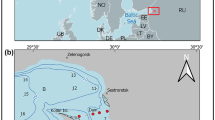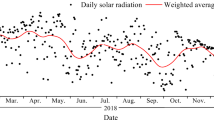Abstract
Because of its importance in pathogen removal and algal productivity in waste stabilization ponds, sunlight penetration was measured in microcosms and in situ under Sahelian climatic conditions. The different wavelengths were detected using a submersible radiometer equipped with three sensors: UV-B (311 nm), UV-A (369 nm) and photosynthetically available radiation (PAR, 400–700 nm). UV-B was more attenuated than UV-A and PAR. Facultative pond was more light-attenuating than maturation pond. The mean euphotic depths for UV-B were 0.20 and 0.31 m, respectively, in the facultative and maturation ponds; PAR penetrated deeper with mean euphotic depths of 0.27 and 0.42 m, respectively. The mean Secchi depths were 0.16 and 0.10 m in the maturation and facultative ponds waters, respectively. In view of the reported results, the contribution of the deeper sections of ponds to pathogen removal mediated by sunlight seems negligible. Therefore, when designing WSPs, these findings should be considered to increase the penetration of damaging wavelengths in order to ensure efficient microbial removal. For more pathogen elimination, downstream shallow ponds could be considered. The paper also shows how suspended solids, turbidity, and Secchi depth are related to the attenuation coefficients and euphotic depths. The developed models could be used to predict light penetration and then algal growth and pathogen removal mediated by sunlight in waste stabilization ponds located in Sahelian climate.


Similar content being viewed by others
References
Ahmed S, Rasul MG, Martens WN, Brown R, Hashib MA (2010) Heterogeneous photocatalytic degradation of phenols in wastewater: a review on current status and developments. Desalination 261:3–18. doi:10.1016/j.desal.2010.04.062
American Public Health Association/American Water Works Association/Water Environment Federation (1998) Standard methods for the examination of water and wastewater, 20th edn. USA, Washington DC
Bitton G (2005) Wastewater microbiology, 3rd edn. John Wiley & Sons, Hoboken
Bolton NF, Cromar NJ, Buchanan NA, Fallowfield HJ (2011) Variations in sunlight attenuation in waste stabilization ponds and environmental waters. In: 9th IWA specialist Conference on Waste Stabilization Ponds. Adelaide, Australia. 1-3 August 2011
Booth CR, Morrow JH (1997) The penetration of UV into natural waters. Photochem Photobiol 65:254–257
Brown R (1984) Relationships between suspended solids, turbidity, light attenuation and algal productivity. Lake Reserv Manage 1:198–205. doi:10.1080/07438148409354510
Craggs RJ, Zwart A, Nagels JW, Davies-Colley RJ (2004) Modelling sunlight disinfection in a high rate pond. Ecol Eng 22:113–122. doi:10.1016/j.ecoleng.2004.03.001
Curtis TP, Mara DD, Dixo NGH, Silva SA (1994) Light penetration in waste stabilization ponds. Water Res 28:1031–1038. doi:10.1016/0043-1354(94)90188-0
Davies-Colley RJ, Vant WN (1987) Absorption of light by yellow substances in freshwater lakes. Limnol Oceanogr 32:416–425
Davies-Colley RJ, Hickey CW, Quinn JM (1995) Organic matter, nutrients and optical characteristics of sewage lagoon effluents. NZJ Mar Freshwat Res 29:235–250
Davies-Colley RJ, Donnison AM, Speed DJ (2000) Towards a mechanistic understanding of pond disinfection. Water Sci Technol 42:149–158
Davies-Colley RJ, Craggs RJ, Park J, Nagels JW (2005) Optical characteristics of waste stabilization ponds: recommendations for monitoring. Water Sci Technol 5:153–161
Dias DFC, von Sperling M (2017) Vertical profiling and modelling of Escherichia coli decay in a shallow maturation pond operating in a tropical climate. Environ Technol In press. doi:10.1080/09593330.2017.1310936
Heaven S, Blanks CJ, Zotova EA (2005) Light attenuation parameters for waste stabilization ponds. Water Sci Technol 51:143–152
Helbling WE, Barbieri ES, Marcoval AM, Gonçalves RJ, Villafane VE (2005) Impact of solar ultraviolet radiation on marine phytoplankton of Patagonia, Argentina. Photochem Photobiol 81:807–818
Huovinen PS, Penttilä H, Soimasuo MR (2003) Spectral attenuation of solar ultraviolet radiation in humic lakes in central Finland. Chemosphere 51:205–214
IWMI and IDRC (International Water Management Institute and International Development Research Centre) (2010) Wastewater irrigation and health: assessing and mitigating risk in low-income countries. Drechsel P, Scott CA, Raschid-Sally L, Redwood M, Bahri A (ed), Earthscan, London
Jiang Y, Rabbi M, Kim M, Ke C, Lee W, Clark RL, Mieczkowski PA, Marszalek PE (2009) UVA generates pyrimidine dimers in DNA directly. Biophys J 96:1151–1158. doi:10.1016/j.bpj.2008.10.030
Joannis C, Ruban G, Gromaire MC, Bertrand-Krajewski JL, Chebbo G (2008) Reproducibility and uncertainty of wastewater turbidity measurements. Water Sci Technol 57:1667–1673
Kadir K, Nelson KL (2014) Sunlight mediated inactivation mechanisms of Enterococcus faecalis and Escherichia coli in clear water versus waste stabilization pond water. Water Res 50:307–314
Kenfack S (2006) Helio-photocatalytic enhancement of the biodegradation of biorecalcitrant pollutants in water: physico-chemical and technical aspects, Thesis no. 3550, EPFL, Lausanne
Kirk JTO (1994) Light and photosynthesis in aquatic ecosystems, 2nd edn. Cambridge University Press, Cambridge
Kirk JTO (1984) Dependence of relationship between inherent and apparent optical properties of water on solar altitude. Limnol Oceanogr 29:350–356
Liltved H, Landfald B (2000) Effects of high intensity light on ultraviolet-irradiated and non-irradiated fish pathogenic bacteria. Water Res 34:481–486
Lindell MJ, Graneli HW, Tranvik LJ (1996) Effects of sunlight on bacterial growth in lakes of different humic content. Aquat Microb Ecol 11:135–141
Maiga Y, Denyigba K, Wethe J, Ouattara AS (2009a) Sunlight inactivation of Escherichia coli in waste stabilization microcosms in a sahelian region (Ouagadougou, Burkina Faso). J Photochem Photobiol B: Biol 94:113–119
Maiga Y, Wethe J, Denyigba K, Ouattara AS (2009b) The impact of pond depth and environmental conditions on sunlight inactivation of E. coli and enterococci in wastewater in a warm climate. Can J Microbiol 55:1364–1374
Mara D (2004) Domestic wastewater treatment in developing countries. Earthscan, London
Mayo AW (1989) Effect of pond depth on bacterial mortality rate. J Environ Eng 115:964–977
Muela A, Garcias-Bringas JM, Arana I, Barcina I (2000) The effect of simulated solar radiation on Escherichia coli: the relative roles of UV-B, UV-A and photosynthetically active radiation. Microbial Ecol 39:65–71
Reinart A, Pedusaar T (2008) Reconstruction of the time series of the underwater light climate in a shallow turbid lake. Aquatic Ecol 42:5–15
Rosati A, Dejong TM (2003) Estimating photosynthetic radiation use efficiency using incident light and photosynthesis of individual leaves. Ann Bot 91:869–877
Stefan HG, Gardoni JJ, Schiebe FR, Cooper CM (1983) Model of light penetration in a turbid lake. Water Resour Res 19:109–120
Sukias JPS, Tanner CC, Davies-Colley RJ, Nagels JW, Wolters R (2001) Algal abundance, organic matter and physico-chemical characteristics of dairy farm facultative ponds. Implications for treatment performance. NZJ Agric Res 44:279–296
Sun CX, Kitajima M, Gin KYH (2016) Sunlight inactivation of somatic coliphage in the presence of natural organic matter. Science of the Total Environ 541:1–7. doi:10.1016/j.scitotenv.2015.08.136
Author information
Authors and Affiliations
Corresponding author
Additional information
Responsible editor: Philippe Garrigues
Rights and permissions
About this article
Cite this article
Maiga, Y., Wethé, J., Ouattara, A.S. et al. Predicting attenuation of solar radiation (UV-B, UV-A and PAR) in waste stabilization ponds under Sahelian climatic conditions. Environ Sci Pollut Res 25, 21341–21349 (2018). https://doi.org/10.1007/s11356-017-9668-z
Received:
Accepted:
Published:
Issue Date:
DOI: https://doi.org/10.1007/s11356-017-9668-z




